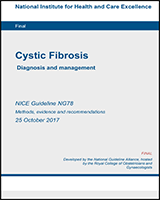From: 9, Pulmonary monitoring, assessment and management

NCBI Bookshelf. A service of the National Library of Medicine, National Institutes of Health.
| Comparison 12. Oscillating device compared to high frequency chest wall oscillation for CF | ||||||
|---|---|---|---|---|---|---|
| Outcomes | Illustrative comparative risks* (95% CI) | Relative effect (95% CI) | No of Participants (studies) | Quality of the evidence (GRADE) | Comments | |
| Assumed risk | Corresponding risk | |||||
| High frequency chest wall oscillation (HFCWO) | Oscillating device (OD) | |||||
| Lung function - FEV1 % predicted Follow-up: 2–4 weeks | The mean FEV1 % predicted in the HFCWO groups was 56.5 | The mean FEV1 % predicted in the OD groups was 1.6 lower (3.44 lower to 0.24 higher) | 24 (Oermann 2001) | ⊕⊕⊕⊝ moderate1 | ||
| Lung function - FVC % predicted Follow-up: 2–4 weeks | The mean FVC % predicted in the HFCWO groups was 74 | The mean FVC% predicted in the OD groups was 1.4 lower (3.07 lower to 0.27 higher) | 24 (Oermann 2001) | ⊕⊕⊝⊝ low1,2 | ||
The basis for the assumed risk (e.g. the median control group risk across studies) is provided in footnotes. The corresponding risk (and its 95% confidence interval) is based on the assumed risk in the comparison group and the relative effect of the intervention (and its 95% CI).
Abbreviations: CI: confidence interval; FEV1: forced expiratory volume in 1 second; FVC: forced vital capacity; HFCWO: high frequency chest wall oscillation; MD: mean difference; OD: oscillating device
The quality of the evidence was downgraded by 1 due to reporting bias.
The quality of the evidence was downgraded by 1 due to serious imprecision as 95% CI crossed a default MID.
From: 9, Pulmonary monitoring, assessment and management

NCBI Bookshelf. A service of the National Library of Medicine, National Institutes of Health.